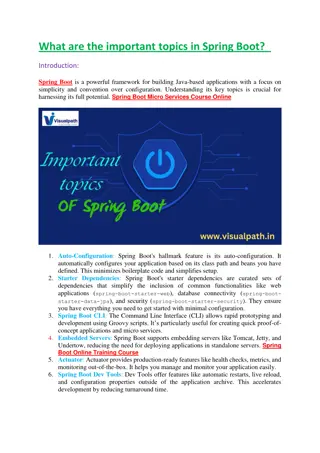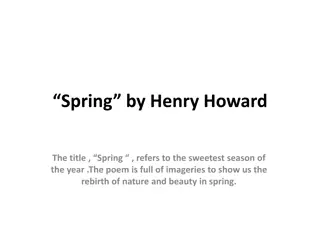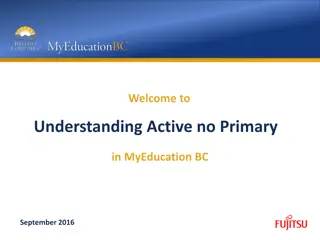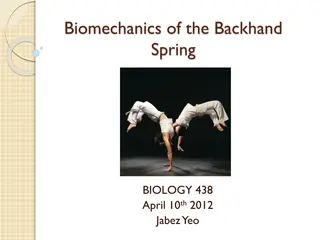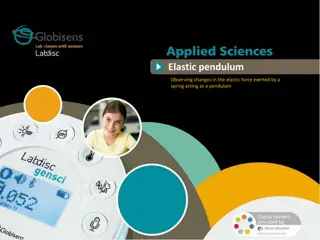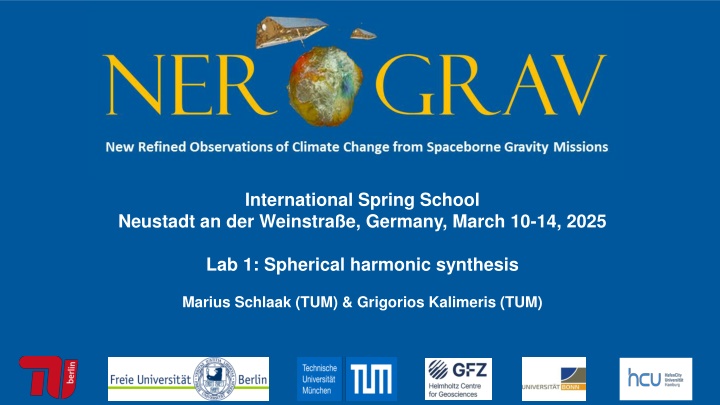
Global Gravity Potential Models for Earth Studies
Join the International Spring School in Germany for practical exercises on GRACE-FO data analysis, including spherical harmonic synthesis and disturbing potential concepts. Explore topics such as spherical harmonic analysis, filtering techniques, and global gravity potential models. Enhance your knowledge on gravity and normal potential variations in reference to Earth's models and ellipsoids.
Download Presentation

Please find below an Image/Link to download the presentation.
The content on the website is provided AS IS for your information and personal use only. It may not be sold, licensed, or shared on other websites without obtaining consent from the author. If you encounter any issues during the download, it is possible that the publisher has removed the file from their server.
You are allowed to download the files provided on this website for personal or commercial use, subject to the condition that they are used lawfully. All files are the property of their respective owners.
The content on the website is provided AS IS for your information and personal use only. It may not be sold, licensed, or shared on other websites without obtaining consent from the author.
E N D
Presentation Transcript
International Spring School Neustadt an der Weinstra e, Germany, March 10-14, 2025 Lab 1: Spherical harmonic synthesis Marius Schlaak (TUM) & Grigorios Kalimeris (TUM)
International Spring School Practicals Four Practical Exercises on GRACE-FO Data Analysis: 1. Spherical Harmonic Analysis 2. Filtering/De-Striping 3. Global Analysis of EWH Grid Data 4. Regional Analysis Spring School, 10-14.3.2025, Schlaak & Kalimeris: Lab 1 Spherical harmonic synthesis 2
Global Gravity potential Models (GGMs) GGMs consist of a set of spherical harmonic coefficients Cnm, Snmreferring to certain GM and R ICGEM format : https://icgem.gfz-potsdam.de/docs/ICGEM-Format-2023.pdf https://icgem.gfz-potsdam.de/docs/ICGEM-Format-2023.pdf Header section Mandatory keywords Static SH coefficients t0 [yyyymmdd] : Reference epoch Time variable SH coefficients period [y] degree (L) order (M) Spherical harmonic (SH) coefficients standard deviation of SH coefficients Spring School, 10-14.3.2025, Schlaak & Kalimeris: Lab 1 Spherical harmonic synthesis 3
Gravity & Normal potential Gravitational potential Gravity potential (gravity field model true Earth): Maximum degree of model W r, , = V + Z Fully normalized associated Legendre polynomials (of degree n and order m) Gravitational constant times mass of the Earth nmax n n+1 V r, , =GMModel RModel r Pnmcos Cnmcosm + Snmsinm RModel n=0 m=0 Radius of the sphere to which the SH series expansion of the model refer Fully normalized SH coefficients (of degree n and order m) = weighting of base functions RModel+ observation altitude; r=RModelon sphere s surface Normal gravitational potential Normal potential (reference ellipsoid model Earth): U r, , = V + Z : angular velocity of the Earth s rotation (precisely known quantity) Centrifugal potential: Z r, =1 2 2r2rsin2 Common for both cases! Spring School, 10-14.3.2025, Schlaak & Kalimeris: Lab 1 Spherical harmonic synthesis 4
Disturbing potential Disturbing potential: T r, , = W U = V V Deviation of the true Earth from a model Earth (reference ellipsoid) in terms of gravity nmax n n+1 T =GMModel RModel RModel r Pnmcos Cnmcosm + Snmsinm n=0 m=0 Coefficient differences (W vs U)! The SH coefficients of the normal potential U need to be scaled so as to correspond to the sphere with radius RModel! See reduce_normpot_grs80 function o Spring School, 10-14.3.2025, Schlaak & Kalimeris: Lab 1 Spherical harmonic synthesis 5
Gravity functionals The disturbing potential constitutes the basis for the computation of various gravity field functionals Geoid heights Height anomaly Gravity disturbances Gravity anomalies Vertical deflections Gravity gradients Spring School, 10-14.3.2025, Schlaak & Kalimeris: Lab 1 Spherical harmonic synthesis 6
Geoid heights Geoid: Equipotential surface which poses the best approximation to the global mean sea surface Geoid height N: Deviation of geoid to reference ellipsoid; unit: [m] SH series expansion: nmax n n+1 N =1 RModel r Pnmcos Cnmcosm + Snmsinm T = RModel n=0 m=0 normal gravity Approximation of normal gravity on the surface of the sphere: Approx=GMModel R2Model Spring School, 10-14.3.2025, Schlaak & Kalimeris: Lab 1 Spherical harmonic synthesis 7
Gravity disturbances Deviation between the norm of measured gravity and normal gravity in a point in space Gravity disturbance g; unit: mGal = milligal = 10 5[m s2] SH series expansion: nmax n n+1n + 1 g = ?T ?r=GMModel RModel RModel r Pnmcos Cnmcosm + Snmsinm r n=0 m=0 Spring School, 10-14.3.2025, Schlaak & Kalimeris: Lab 1 Spherical harmonic synthesis 8
Gravity gradients Rate of change of gravitational attraction in a spatial direction m m] s2 Gravity gradient Trr; unit: E:E tv s = 10 9[ SH series expansion: nmax n n+1n + 1 (n + 2) Trr=? T ?2r=GMModel RModel RModel r Pnmcos Cnmcosm + Snmsinm r2 n=0 m=0 Spring School, 10-14.3.2025, Schlaak & Kalimeris: Lab 1 Spherical harmonic synthesis 9
Lab 1 Goals Become acquainted with different gravity functionals Understand the impact of the degree of expansion Understand the impact of observation altitude Understand (roughly) the scale of the static gravity signal and its temporal variations Spring School, 10-14.3.2025, Schlaak & Kalimeris: Lab 1 Spherical harmonic synthesis 10
Lab 1 Walkthrough Task 1 (1) Read gravity field model ITSG-GRACE2018s See readicgem function Generate disturbing potential coefficients by subtracting the GRS80 normal potential See reduce_normpot_grs80 function Spring School, 10-14.3.2025, Schlaak & Kalimeris: Lab 1 Spherical harmonic synthesis 11
Lab 1 Walkthrough Task 1 (2) SH coefficients format SC-format CS-format degree n Snm 0 0 degree n degree n order m Snm Cnm Cnm order m order m order m Spring School, 10-14.3.2025, Schlaak & Kalimeris: Lab 1 Spherical harmonic synthesis 12
Lab 1 Walkthrough Task 2 Compute global geoid heights up to various maximum harmonic degrees See shs function Plot (with coastlines!) and interpret your results longitude & colatitude (parameters of shs) lon=[0:360] ; col=[0:180] global grid (output of shs) coastlines (coast30.mat coast.npz) Spring School, 10-14.3.2025, Schlaak & Kalimeris: Lab 1 Spherical harmonic synthesis 13
Lab 1 Walkthrough Task 3 Compute and visualize global grids of gravity disturbances and vertical gravity gradients up to various maximum harmonic degrees (analogously to task 2) See shs function How does the spatial signal change for each of the investigated gravity functionals? Why? See SH series expansion equations Spring School, 10-14.3.2025, Schlaak & Kalimeris: Lab 1 Spherical harmonic synthesis 14
Lab 1 Walkthrough Task 4 How does the observable gravity signal change with increasing altitude? Compute and visualize gravity disturbances as seen from various satellite altitudes See shs function Based on your findings so far, which conclusions regarding altitude and observation technique can be drawn for a real gravity field mission? Spring School, 10-14.3.2025, Schlaak & Kalimeris: Lab 1 Spherical harmonic synthesis 15
Lab 1 Walkthrough Task 5 Import the gravity field model of April 2004 and visualize the corresponding geoid heights. Can you visually recognize any differences to the static model s geoid heights? Visualize this model s deviation to the long-term mean (= static model). Do you notice anything specific about the signal s behaviour? Generate model differences on coefficients level! Spring School, 10-14.3.2025, Schlaak & Kalimeris: Lab 1 Spherical harmonic synthesis 16
Access to Practical Material Instructions, Data, and Source Code are available on the Spring school website https://www.asg.ed.tum.de/iapg/nerograv/spring-school/practicals/ Spring School, 10-14.3.2025, Schlaak & Kalimeris: Lab 1 Spherical harmonic synthesis 17
Appendix (1) n m Rnm ( , ) + = + = + + = 0 0 P00 cos( 0 ) 0 . 1 mean - + 4 0 P40 cos( 0 ) 9 . 0 zonal = P55 cos( 5 ) 5 5 1 . 1 sectorial P cos( 8 ) 11 8 11 8 , 6 . 0 tesseral Spring School, 10-14.3.2025, Schlaak & Kalimeris: Lab 1 Spherical harmonic synthesis 18
Appendix (2) order m order m C00 C10 S11 C11 degree n S22 S21 C20 C21 C22 S33 S32 S31 C30 C31 C32 C33 C40 C41 C42 C43 C44 S44 S43 S42 S41 S55 S54 S53 S52 S51 C50 C51 C52 C53 C54 C55 sectorial sectorial tesseral zonal tesseral Spring School, 10-14.3.2025, Schlaak & Kalimeris: Lab 1 Spherical harmonic synthesis 19




